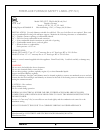
STEP 2 – CONCRETE PAD & HEARTH EXTENSIONS
Determine whether the fireplace is to be installed on an outside wall or an inside wall. The
clearances for an inside wall installation differ from an outside wall installation. The type
of wall installation will impact the size of the concrete pad and hearth extension to be
poured. Ensure conformance to all local building codes. Void areas are often provided in
the base to form an air passage for external combustion air (recommended), or an opening for an
ash pit or for both. Any nonessential void areas below the hearth should be filled to avoid
unwanted air leakage into the furnace. Immediately above the foundation or foundation walls,
pouring a concrete pad and creating the required hearth extension will create support for the
fireplace furnace and allow an interface to the floor joists. Corbelling may be used to support the
hearth extension, but a poured concrete slab, that also supports the fireplace furnace, usually is used
to create a hearth extension. Forming the concrete pad requires “block outs” for external
combustion air dampers (recommended.) Forming the concrete pad requires an interface with the
ash dump provided in the Smart Fireplace Furnace. The concrete pad ash dump block out should
be larger than the opening provided for the ash dump in the bottom of the fireplace furnace floor.
If a Smart Fireplace Furnace is to be ducted down to a lower level, then include block outs in the
concrete pad for the hot air ducting. Refer to FIGURE 3 for a typical outside wall fireplace furnace
installation and refer to FIGURE 4 for a typical inside wall fireplace furnace installation. Note that
both drawings include block outs for down duct capability.
FIGURE 3: OUTSIDE WALL PAD INSTALLATION
Use of non-combustible forms will be required for the concrete pad since removal of these forms
will not be possible once the concrete pour is complete. Corrugated galvanized sheet metal can be
used for the concrete pad form to eliminate any future fire hazard. NOTE: ALL combustible
forms used in the hearth extension and concrete pad must not be left in place once the concrete
pour is complete. The concrete pad must be a minimum of eight inches thick and be capable of
resisting thermal stresses resulting from high temperatures. Check local building codes and
specific requirements in order to define the proper thickness requirement of the concrete pad and
hearth extension for your specific fireplace furnace application.
Hearth extensions must be constructed of noncombustible materials. A U.L. listed hearth
extension may be used or the hearth extension can be a continuation of the poured concrete pad.
Version 7.1
6


















